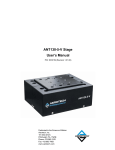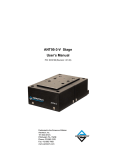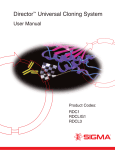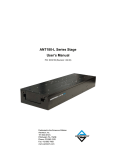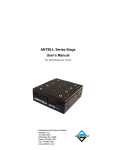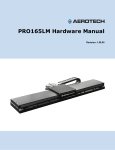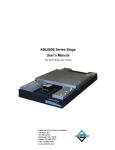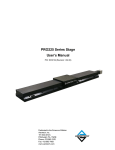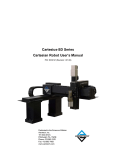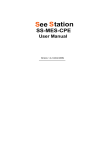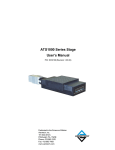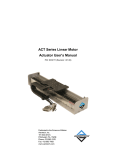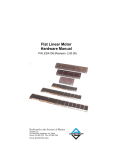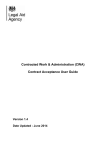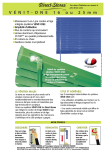Download ANT130 Series Stage User`s Manual
Transcript
ANT130 Series Stage User’s Manual P/N: EDS145 (Revision 1.03.00) Dedicated to the Science of Motion Aerotech, Inc. 101 Zeta Drive, Pittsburgh, PA, 15238 Phone: 412-963-7470 Fax: 412-963-7459 www.aerotech.com Technical Support Aerotech provides downloadable resources (such as up-to-date software, product manuals, and Help files), training schedules, and PC-to-PC remote technical support. You can also complete Product Return (RMA) forms and get information about repairs and spare or replacement parts. Go to http://www.aerotech.com/cussv.html for information and support about your Aerotech products. For immediate help, contact a service office (listed below) or your sales representative. United States (World Headquarters) Phone: (412) 967-6440 Fax: (412) 967-6870 Email: [email protected] Japan Phone: +81(0)47-489-1742 Fax: +81(0)47-489-1743 Email: [email protected] United Kingdom Phone: +44 118 940 9400 Fax: +44 118 940 9401 Email: [email protected] China Phone: +852-3793-3488 Email: [email protected] Germany Phone: +49 911 967 9370 Fax: +49 911 967 93720 Email: [email protected] Taiwan Phone: +886 (0)2-8502-6651 Email: [email protected] N O T E : Aerotech continually improves its product offerings; listed options may be superseded at any time. Refer to the most recent edition of the Aerotech Motion Control Product Guide for the most current product information at www.aerotech.com. N O T E : All drawings and illustrations are for reference only and were complete and accurate as of this manual’s release. The most recent system drawings and schematics can be found on your software CD ROM or on www.aerotech.com. N O T E : This manual and any additional instructions included with the ANT130 should be read in their entirety before operating the ANT130 . N O T E : This product is intended for light industrial manufacturing or laboratory use. Revision History 1.03.00 January 30, 2012 1.02.00 November 5, 2010 1.01.00 April 23, 2010 1.00.00 November 18, 2009 Product names mentioned herein are used for identification purposes only and may be trademarks of their respective companies. Copyright © 2009 - 2012. Aerotech, Inc. All Rights Reserved. ANT130 Series Stage User's Manual Table of Contents Table of Contents Table of Contents List of Figures List of Tables iii v vii Chapter 1: Overview 1 1.1. Standard Features 1.1.1. Optional Features 1.1.2. Model Numbers 1.2. Dimensions 1.3. Safety Procedures and Warnings 1.4. EC Declaration of Incorporation Chapter 2: Installation 2.1. Unpacking and Handling the Stage 2.2. Shipping Brackets 2.3. Preparing the Mounting Surface 2.4. Securing the Stage to the Mounting Surface 2.5. Attaching the Payload to the Stage 2.6. Electrical Installation 2 2 3 4 7 8 9 9 10 13 14 15 16 Chapter 3: Operating Specifications 17 3.1. Environmental Specifications 3.2. Accuracy and Temperature Effects 3.3. Basic Specifications 3.4. Load Capability 3.5. Limit Switches 3.5.1. Limit Switch Wiring 3.6. Standard Motor Wiring 3.7. Vacuum Operation 3.7.1. Special Guidelines 17 18 19 24 29 29 30 34 34 Chapter 4: Maintenance 4.1. Service and Inspection Schedule 4.2. Cleaning and Lubrication 4.2.1. Recommended Cleaning Solvents 4.2.2. Important Notes on Lubrication 4.2.3. Lubrication and Cleaning Process Chapter 5: ANT130-L-Z 5.1. Standard Features 5.1.1. Model Numbers 5.2. Dimensions 5.3. Basic Specifications 5.4. Z-Axis Installation 5.4.1. Securing the Stage to the Mounting Surface 5.4.2. Attaching the Payload to the Stage 35 35 36 36 36 36 37 37 39 40 41 42 42 44 Appendix A: Warranty and Field Service 45 Appendix B: Technical Changes 47 Index 49 Reader's Comments 51 www.aerotech.com iii Table of Contents iv ANT130 Series Stage User's Manual www.aerotech.com ANT130 Series Stage User's Manual List Of Figures List of Figures Figure 1-1: Figure 1-2: Figure 1-3: Figure 1-4: Figure 2-1: Figure 2-2: Figure 2-3: Figure 2-4: Figure 2-5: Figure 2-6: Figure 2-7: Figure 3-1: Figure 3-2: Figure 3-3: Figure 3-4: Figure 3-5: Figure 3-6: Figure 3-7: Figure 3-8: Figure 3-9: Figure 3-10: Figure 3-11: Figure 5-1: Figure 5-2: Figure 5-3: Figure 5-4: ANT130-L (left) and ANT130-XY (right) Linear Positioning Stage ANT130-L Dimensions ANT130-XY Dimensions ANT130-XY CMS Dimensions Shipping Bracket Used on Single Axis Stages Shipping Brackets Used on XY Systems ANT130-XY Shipping Bracket Removal Procedure (Step 1) ANT130-XY Shipping Bracket Removal Procedure (Step 2) ANT130-XY Shipping Bracket Removal Procedure (Step 3) Mounting to a Flat Surface Mounting Hole Locations Stage Loading Conditions Load Capability of ANT130-035-L Stages Load Capability of ANT130-060-L Stages Load Capability of ANT130-110-L Stages Load Capability of ANT130-160-L Stages Load Capability of ANT130-060-XY Stages Load Capability of ANT130-110-XY Stages Load Capability of ANT130-160-XY Stages ANT130 Series Limit Switch Wiring Motor Wiring Connector for Optional 4 pin Hi-Power D Connector (-4DU-25DU Option) Encoder Connector with Optional 4 pin Hi-Power D Connector (-4DU-25DV Option) Typical ANT130L-Z Series Positioning Stage ANT130L-Z with Component Labeling ANT130-L-Z Dimensions ANT130L-Z Mounting Pattern www.aerotech.com 1 4 5 6 10 10 11 11 12 13 14 24 25 25 26 26 27 27 28 29 32 32 37 38 40 42 v List of Figures vi ANT130 Series Stage User's Manual www.aerotech.com ANT130 Series Stage User's Manual List of Tables List of Tables Table 1-1: Table 1-2: Table 3-1: Table 3-2: Table 3-3: Table 3-4: Table 3-5: Table 3-6: Table 5-1: Table 5-2: Table B-1: Table B-2: Model Numbering System for Single Axis Stage Model Numbering System for Two Axis XY Stage Environmental Specifications ANT130-L Series Specifications ANT130-XY Series Specifications BLMUC-95-A Motor Specifications Feedback and Motor Pin Assignments for -25DU Cable Option Motor and Feedback Wiring Pinout Descriptions Model Numbering System ANT130L-Z Series Specifications Current Changes (1.03.00) Archived Changes www.aerotech.com 3 3 17 19 21 23 31 33 39 41 47 48 vii List of Tables viii ANT130 Series Stage User's Manual www.aerotech.com ANT130 Series Stage User's Manual Overview Chapter 1: Overview The ANT130-L and ANT130-XY series stages offer excellent performance in speed, accuracy, resolution, repeatability, reliability, travel range, and are offered in two accuracy grades. With its low profile and outstanding performance characteristics, the ANT130 stages are the ultimate solution for high-accuracy alignment, inspection, positioning, and measurement stations. Figure 1-1: www.aerotech.com ANT130-L (left) and ANT130-XY (right) Linear Positioning Stage Chapter 1 1 Overview ANT130 Series Stage User's Manual 1.1. Standard Features The ANT130 series stages incorporate linear cross-roller bearings, a linear motor, and a non-contact linear encoder. These features allow the ANT130 series stages to provide excellent performance in speed, accuracy, resolution, repeatability, and reliability. The linear cross-roller bearings offer excellent stiffness, high load carrying capabilities, and minimal friction for smooth movement. The cross roller bearings also incorporate a system to prevent cage creep and keep the rollers centered in the bearing rails. The ANT130 series stages are driven by a linear motor. The brushless linear motor uses an ironless forcer, which means there is zero cogging and there are no attractive forces – resulting in unsurpassed smoothness of motion. A moving magnet track design eliminates the need for cable management, improving long-term reliability. A high-accuracy, non-contact linear encoder allows the ANT130 series stages to have an incremental step size of 1 nm when coupled with Aerotech drives and controls. This is especially useful in alignment applications, where outstanding step-to-step resolution is critical. The single axis, linear ANT130 has four standard travel distances: 35mm, 60mm, 110mm, and 160mm. The two-axis X-Y ANT130 offers three standard travel distance combinations: 60mm x 60mm, 110mm x 110mm, and 160mm x 160mm. Optical limit switches are mounted at each end of travel. These switches are configured as normally-closed. If the stage is driven beyond these electrical limits, a mechanical, shock absorbing hard stop limits carriage movement. 1.1.1. Optional Features ANT130 stages can be ordered as a single axis, ANT130-L, or as and integrated X-Y stage, ANT130-XY. The ANT130 stages also have the option of two accuracy grades. There is the standard ANT130 stage accuracy, or the high accuracy grade (“-PLUS” designation) ANT130 stage. ANT130 stages come standard with a single, 25-pin D connector (per axis), however there is the option to have a 4-pin hi-power D and 25-pin D connector for applications that require bus voltages greater than 80 V. For vacuum applications, two vacuum preparation options are available; one compatible with low vacuum environments (down to 10-3 torr) and the other for high vacuum (10-3 to 10-6 torr). Custom configurations, such as XY-Z systems are common and readily available. Contact Aerotech for more details on optional features and configurations. 2 Chapter 1 www.aerotech.com ANT130 Series Stage User's Manual Overview 1.1.2. Model Numbers Stage model number example: ANT130-110-L-PLUS-25DU The tables below list the available options in the order they appear in the example above. Aerotech continually improves its product offerings, and listed options may be superseded at any time. Refer to the most recent edition of the Aerotech Motion Control Product Guide for the most current product information at www.aerotech.com. Table 1-1: Model Numbering System for Single Axis Stage ANT130-L Series Linear Motor Stage ANT130-035-L ANT130-035-L-PLUS ANT130-060-L ANT130-060-L-PLUS ANT130-110-L ANT130-110-L-PLUS ANT130-160-L ANT130-160-L-PLUS 35 mm travel stage with linear motor and limits 35 mm travel stage with linear motor and limits, high accuracy 60 mm travel stage with linear motor and limits 60 mm travel stage with linear motor and limits, high accuracy 110 mm travel stage with linear motor and limits 110 mm travel stage with linear motor and limits, high accuracy 160 mm travel stage with linear motor and limits 160 mm travel stage with linear motor and limits, high accuracy Output Cable Connectors -25DU Single 25-pin D connector (standard) -4DU-25DU 4-pin HPD and 25-pin D connectors Note: -25DU single 25-pin connector option not valid for systems using bus voltages greater than 80 V Table 1-2: Model Numbering System for Two Axis XY Stage ANT130-XY Series Linear Motor Stage ANT130-060-XY ANT130-060-XY-PLUS ANT130-110-XY ANT130-110-XY-PLUS ANT130-160-XY ANT130-160-XY-PLUS 60 mm travel stage with linear motor and limits 60 mm travel stage with linear motor and limits, high accuracy 110 mm travel stage with linear motor and limits 110 mm travel stage with linear motor and limits, high accuracy 160 mm travel stage with linear motor and limits 160 mm travel stage with linear motor and limits, high accuracy Cable Management System Options -XY-CMS CMS Cable management system for X-Y assembly -XYZ-CMS Cable management system for 3-axis assembly (XY stage plus additional axis on top) Output Cable Connectors -25DU Single 25-pin D connector (standard) -4DU-25DU 4-pin HPD and 25-pin D connectors Note: -25DU single 25-pin connector option not valid for systems using bus voltages greater than 80 V www.aerotech.com Chapter 1 3 Overview ANT130 Series Stage User's Manual 1.2. Dimensions Figure 1-2: 4 ANT130-L Dimensions Chapter 1 www.aerotech.com ANT130 Series Stage User's Manual Overview RAD. F CABLE BEND RADIUS 25 Ø12.7 D/2 21X M61.0 7.0 CENTER ON CARRIAGE C/2 25 50 Ø6.8 75 120 8 DETAIL A SCALE 2 : 5 MOUNTING HOLE TYP. B/2 D/2 50 75 B/2 90 C/2 D/2 125 D/2 MODEL A = STAGE LENGTH B = NOMINAL TRAVEL C = LIMIT TRAVEL D = HARDSTOP TRAVEL E F ANT130-060-XY 180 60 X 60 66 X 66 75 X 75 42 ~87.5 ANT130-110-XY 230 110 X 110 116 X 116 125 X 125 67 ~100 ANT130-160-XY 280 160 X 160 166 X 166 175 X 175 92 ~112.5 130 A 85 A E 120 1 90 200 130 A DIMENSIONS: MILLIMETERS 1 ANT130-110-XY AND ANT130-160-XY ONLY Figure 1-3: www.aerotech.com ANT130-XY Dimensions Chapter 1 5 Overview ANT130 Series Stage User's Manual ±45° CENTER POST ADJUSTMENT 82.6 SQ 50 SQ AIR FITTING FOR Ø4 [Ø5/32”] VACUUM LINE (ALTERNATE ATTACHMENT METHOD) 4X Ø6.8 SLOT THRU ALL Ø11.0 SLOT 8.0 50.8 SQ 38.1 CABLE TIE MOUNTS (BOTH SIDES) 130.2 38.1 38.1 82.6 44.4 34.9 25.4 ACP3: INCLUDED WITH -XYZ-CMS OPTION 11.8 11.1 REF NOTE: [QTY 4] MAGNETS (ALTERNATE ATTACHMENT METHOD) ACP2: INCLUDED WITH -XY-CMS OPTION Figure 1-4: 6 DIMENSIONS NOT SHOWN ARE THE SAME AS ACP2 DIMENSIONS: MILLIMETERS ANT130-XY CMS Dimensions Chapter 1 www.aerotech.com ANT130 Series Stage User's Manual Overview 1.3. Safety Procedures and Warnings The following statements apply wherever the Warning or Danger symbol appears within this manual. Failure to observe these precautions could result in serious injury to those individuals performing the procedures and/or damage to the equipment. Operators should be trained before operating this equipment. D A N G E R : To minimize the possibility of electrical shock and bodily injury or death, disconnect all electrical power prior to making any electrical connections. D A N G E R : To minimize the possibility of electrical shock and bodily injury or death when any electrical circuit is in use, ensure that no person comes in contact with the circuitry when the ANT130 is connected to a power source. D A N G E R : To minimize the possibility of bodily injury or death, disconnect all electrical power prior to making any mechanical adjustments. D A N G E R : Moving parts of the ANT130 can cause crushing or shearing injuries. All personnel must remain clear of any moving parts. W A R N I N G : If the ANT130 is used in a manner not specified by the manufacturer, the protection provided by the ANT130 can be impaired and result in damage, shock, injury or death. W A R N I N G : Cables can pose a tripping hazard. Securely mount and position all ANT130 cables to avoid potential hazards. W A R N I N G : Do not expose the ANT130 to environments or conditions outside the specified range of operating environments. Operation in conditions other than those specified can cause damage to the equipment. W A R N I N G : The ANT130 must be mounted securely. Improper mounting can result in injury and damage to the equipment. W A R N I N G : Use care when moving the ANT130. Manually lifting or transporting the ANT130 can result in injury. W A R N I N G : Only trained personnel should operate, inspect, and maintain the ANT130. W A R N I N G : This ANT130 is intended for light industrial manufacturing or laboratory use. Use of the ANT130 for unintended applications can result in injury and damage to the equipment. W A R N I N G : Before using this ANT130, perform an operator risk assessment to determine the needed safety requirements. www.aerotech.com Chapter 1 7 Overview ANT130 Series Stage User's Manual 1.4. EC Declaration of Incorporation Manufacturer: Aerotech, Inc. 101 Zeta Drive Pittsburgh, PA 15238 USA herewith declares that the product: Aerotech, Inc. ANT130 Stage is intended to be incorporated into machinery to constitute machinery covered by the Directive 2006/42/EC as amended; does therefore not in every respect comply with the provisions of this directive; and that the following harmonized European standards have been applied: EN ISO 12100-1,-2:2003+A1:2009 Safety of machinery - Basic concepts, general principles for design ISO 14121-1:2007 Safety of machinery - Risk assessment - Part 1: Principles EN 60204-1:2005 Safety of machinery - Electrical equipment of machines - Part 1: General requirements and further more declares that it is not allowed to put the equipment into service until the machinery into which it is to be incorporated or of which it is to be a component has been found and declared to be in conformity with the provisions of the Directive 2006/42/EC and with national implementing legislation, i.e. as a whole, including the equipment referred to in this Declaration. Authorized Representative: Address: Name Position Location Date 8 Manfred Besold AEROTECH GmbH Süd-West-Park 90 D-90449 Nürnberg / Alex Weibel Engineer Verifying Compliance Pittsburgh, PA September 2010 Chapter 1 www.aerotech.com ANT130 Series Stage User's Manual Installation Chapter 2: Installation This chapter describes the installation procedure for the ANT130 stage, including handling the stage, preparing the mounting surface to accept the stage, securing the stage to the mounting surface, attaching the payload, and making the electrical connections. W A R N I N G : Installation must follow the instructions in this chapter. Failure to follow these instructions could result in injury and damage to the equipment. 2.1. Unpacking and Handling the Stage Carefully remove the stage from the protective shipping container. Use compressed nitrogen or clean, dry air to remove any dust or debris that has collected during shipping. Visually inspect the stage for damage. If any damage has occurred during shipping report it immediately. Remove stage shipping brackets. Set the stage on a smooth, flat, and clean surface. This is a simple, yet very important step in maintaining the integrity of the stage. Each stage has a label listing the system part number and serial number. These numbers contain information necessary for maintaining or updating system hardware and software. Locate this label and record the information for later reference. W A R N I N G : Improper handling could adversely affect the ANT130’s performance. Use care when moving the stage. Manually lifting or transporting the stage can result in injury. W A R N I N G : Lift the ANT130 only by the base. www.aerotech.com Chapter 2 9 Installation ANT130 Series Stage User's Manual 2.2. Shipping Brackets Aerotech provides shipping brackets to prevent unwanted stage motion and potential damage from occurring during shipment. The brackets are red anodized aluminum, and they must be removed from the stage before it can operate. There are two types of shipping brackets: one type for the linear stages (ANT130-L) and one type for the integrated XY stages (ANT130-XY). Figure 2-1 shows the shipping brackets used to constrain single axis stages. Figure 2-2 shows the shipping brackets used to constrain XY systems. Figure 2-3, Figure 2-4, and Figure 2-5 show how to properly remove the shipping brackets used on XY systems. Figure 2-1: Figure 2-2: 10 Shipping Bracket Used on Single Axis Stages Shipping Brackets Used on XY Systems Chapter 2 www.aerotech.com ANT130 Series Stage User's Manual Installation Figure 2-3: ANT130-XY Shipping Bracket Removal Procedure (Step 1) Figure 2-4: ANT130-XY Shipping Bracket Removal Procedure (Step 2) www.aerotech.com Chapter 2 11 Installation ANT130 Series Stage User's Manual Figure 2-5: ANT130-XY Shipping Bracket Removal Procedure (Step 3) N O T E : After removing the lifting features or shipping brackets, retain them for future use. In the event that the product requires service at the factory, the lifting features or shipping brackets should be reattached to ensure that the ANT130 ships safely. 12 Chapter 2 www.aerotech.com ANT130 Series Stage User's Manual Installation 2.3. Preparing the Mounting Surface The mounting surface should be flat to 5 μm and have adequate stiffness in order to achieve the maximum performance from the ANT130. When an ANT130 series stage is mounted to a warped surface, the stage can be distorted as the mounting screws are tightened (see Figure 2-6). Any distortion will decrease the overall accuracy of the stage. Adjustments to the mounting surface must be done before the stage is secured. Figure 2-6: Mounting to a Flat Surface N O T E : To maintain accuracy, the mounting surface should be flat within 5 µm . N O T E : The ANT130 base is precision machined and verified for flatness prior to product assembly at the factory. If machining is required to achieve the desired flatness, it should be performed on the mounting surface rather than the ANT130 base. Shimming should be avoided if possible. If shimming is required, it should be minimized to improve the rigidity of the system. www.aerotech.com Chapter 2 13 Installation ANT130 Series Stage User's Manual 2.4. Securing the Stage to the Mounting Surface Move the stage table to access the 6.8 mm (0.27 in) diameter mounting holes along the edges of the stage. This stage is designed to use socket head cap screws (SHCS) to secure the base to the mounting surface. Use M6 x 18 mm or 1/4 x 3/4" long SHCS to achieve 1.5x diameter thread engagement. Torque the mounting screws to 5.4 N*m (4 ft*lb). W A R N I N G : The ANT130 must be mounted securely. Improper mounting can result in injury and damage to the equipment. W A R N I N G : Do not attempt to manually move the ANT130 if it is connected to a power source. Figure 2-7: 14 Mounting Hole Locations Chapter 2 www.aerotech.com ANT130 Series Stage User's Manual Installation 2.5. Attaching the Payload to the Stage To prevent damage to the stage or parts, test the operation of the stage before any payload is mounted to the stage tabletop. Proceed with the electrical installation and test the motion control system in accordance with the system documentation. Document all results for future reference. For information on electrical connections, refer to the Electrical Installation section later in this chapter, the documentation of the motion control system delivered with the stage, and the wiring drawings in Chapter 3: Operating Specifications. N O T E : For valid system performance, the mounting interface should be flat within 1 µm per 50 mm. The payload should be flat, rigid, and comparable to the stage in quality. Refer to Section 3.4. for information on cantilevered loads and load positioning. N O T E : Do not attach a payload to the stage table with screws that are too long. A screw passing through the stage table can come into contact with internal parts, affecting travel and possibly damaging the stage. Mounting screws should not project more than 7 mm (.276") into the stage table top. www.aerotech.com Chapter 2 15 Installation ANT130 Series Stage User's Manual 2.6. Electrical Installation Electrical installation requirements will vary depending on stage options. Installation instructions in this section are for stages equipped with standard Aerotech linear motors intended for use with an Aerotech motion control system. Contact Aerotech for further information regarding stages that are otherwise configured. Aerotech motion control systems are adjusted at the factory for optimum performance. When the ANT130 is part of a complete Aerotech motion control system, setup usually involves connecting a stage and motor combination to the appropriate drive chassis with the cables provided. Connect the provided cables to the feedback and motor connectors on the stage body. Labels on the system components usually indicate the appropriate connections. Refer to the appropriate system manuals and documentation for additional installation and operation information. If the system is uniquely configured, a drawing showing system interconnects is supplied. An integral linear motor comes mounted to all ANT130 stages. The electrical wiring from the motor and encoder are integrated into two main connectors at the factory. Refer to Section 3.6. for standard motor wiring and connector pin outputs. W A R N I N G : Never connect or disconnect any electrical component or connecting cable while power is applied, or serious damage can result. W A R N I N G : The stage's protective ground is integrated into the motor and encoder connector. If you are using cables other than those provided by Aerotech, you must connect the pin listed as the ground in Section 3.6. to a ground connection. 16 Chapter 2 www.aerotech.com ANT130 Series Stage User's Manual Operating Specifications Chapter 3: Operating Specifications The surrounding environment and operating conditions can affect the performance and service life of the stage. This chapter provides information on ideal environmental and operating conditions. Also included are instructions for estimating load capability given various loadings. 3.1. Environmental Specifications The environmental specifications for the are listed in the following table. Table 3-1: Environmental Specifications Ambient Temperature Operating: 10° to 35° C (50° to 95° F) The optimal operating temperature is 20° C ±2° C (68° F ±4° F). If at any time the operating temperature deviates from 20° C degradation in performance could occur. Contact Aerotech for information regarding your specific application and environment. Storage: 0° to 40° C (32° to 104° F) in original shipping packaging Humidity Operating: 20% to 60% RH Storage: 10% to 70% RH, non-condensing in original packaging Altitude Operating: 0 m to 2,000 m (0 ft to 6,562 ft) above sea level Contact Aerotech if your specific application involves use above 2,000 m or below sea level. Vibration Use the system in a low vibration environment. Excessive floor or acoustical vibration can affect stage and system performance. Contact Aerotech for information regarding your specific application. Dust Exposure The ANT130 stages are not suited for dusty or wet environments. This equates to an ingress protection rating of IP00. Use Indoor use only W A R N I N G : Do not expose the ANT130 to environments or conditions outside the specified range of operating environments. Operation in conditions other than those specified can cause damage to the equipment. www.aerotech.com Chapter 3 17 Operating Specifications ANT130 Series Stage User's Manual 3.2. Accuracy and Temperature Effects The accuracy specification of ANT130 series stages is measured at the center of travel 25 mm above the tabletop with the stage in a horizontal position. The stage is assumed to be fully supported by a mounting surface meeting or exceeding the specification in Section 2.3. Extreme temperature changes could cause a decrease in performance or permanent damage to the stage. Aerotech stages are designed for and built in a 20°C (68°F) environment. Any deviation from standard operating temperature will affect stage accuracy. The severity of temperature effects on all stage specifications depends on many different environmental conditions, including how the stage is mounted. Contact the factory for more details. The thermal expansion coefficient of the encoder scale is 3.25 ppm/°C. Travel will increase or decrease at this rate as the temperature of the encoder scale temperature deviates from 20°C (68°F). 18 Chapter 3 www.aerotech.com ANT130 Series Stage User's Manual Operating Specifications 3.3. Basic Specifications Basic ANT130 series positioning stage specifications are shown in Table 3-2 and Table 3-3. Resolution is dependent on encoder resolution and controller interpolation. Specifications for the standard BLMUC-95-A motor are given in Table 3-4. Table 3-2: ANT130-L Series Specifications Mechanical Specifications Travel Accuracy [1] Resolution Repeatability (Bi-Directional) [1] Repeatability (Uni-Directional) Straightness [1] Flatness [1] Pitch Roll Yaw Maximum Speed Maximum Acceleration In-Position Stability [2] Maximum Force (Continuous) Horizontal Load Capacity [3] Side Moving Mass Stage Mass Material MTBF (Mean Time Between Failure) ANT130-035-L 35 mm ±2 µm (±80 µin) 1 nm (0.04 µin) ±100 nm (±4 µin) ±25 nm (±1 µin) ±1.0 µm (±40 µin) ±1.0 µm (±40 µin) 10 arc sec 10 arc sec 5 arc sec 350 mm/s (14 in/s) 1 g - 10 m/s2 (No Load) <1 nm (<0.04 µin) 23 N 12.0 kg (26.5 lb) 10 kg (22 lb) 1.2 kg (2.6 lb) 2.1 kg (4.6 lb) ANT130-035-LPLUS ANT130-060-L ANT130-060-LPLUS 35 mm 60 mm 60 mm ±250 nm ±2 µm ±250 nm (±10 µin) (±80 µin) (±10 µin) 1 nm (0.04 µin) 1 nm (0.04 µin) 1 nm (0.04 µin) ±75 nm ±100 nm ±75 nm (±3 µin) (±4 µin) (±3 µin) ±25 nm ±25 nm ±25 nm (±1 µin) (±1 µin) (±1 µin) ±1.0 µm ±1.0 µm ±1.0 µm (±40 µin) (±40 µin) (±40 µin) ±1.0 µm ±1.0 µm ±1.0 µm (±40 µin) (±40 µin) (±40 µin) 10 arc sec 10 arc sec 10 arc sec 10 arc sec 10 arc sec 10 arc sec 5 arc sec 5 arc sec 5 arc sec 350 mm/s 350 mm/s 350 mm/s (14 in/s) (14 in/s) (14 in/s) 1 g - 10 m/s2 1 g - 10 m/s2 1 g - 10 m/s2 (No Load) (No Load) (No Load) <1 nm <1 nm <1 nm (<0.04 µin) (<0.04 µin) (<0.04 µin) 23 N 23 N 23 N 12.0 kg (26.5 lb) 12.0 kg (26.5 lb) 12.0 kg (26.5 lb) 10 kg (22 lb) 10 kg (22 lb) 10 kg (22 lb) 1.2 kg (2.6 lb) 1.4 kg (3.1 lb) 1.4 kg (3.1 lb) 2.1 kg (4.6 lb) 2.5 kg (5.5 lb) 2.5 kg (5.5 lb) Aluminum Body/Black Hardcoat Finish 30,000 Hours 1. Certified with each stage. 2. In-Position Stability listing is 3σ value. 3. Axis orientation for on-axis loading is listed. 4. Specifications are for single-axis systems measured 25 mm above the tabletop. Performance of multi-axis systems is payload and workpoint dependent. Consult factory for multi-axis or non-standard applications. 5. -PLUS requires the use of an Aerotech controller. www.aerotech.com Chapter 3 19 Operating Specifications ANT130 Series Stage User's Manual Table 3-2: ANT130-L Series Specifications (continued) Mechanical Specifications Travel Accuracy [1] Resolution Repeatability (Bi-Directional) [1] Repeatability (Uni-Directional) Straightness [1] Flatness [1] Pitch Roll Yaw Maximum Speed Maximum Acceleration In-Position Stability [2] Maximum Force (Continuous) Horizontal Load Capacity [3] Side Moving Mass Stage Mass Material MTBF (Mean Time Between Failure) ANT130-110-L 110 mm ±3 µm (±120 µin) 1 nm (0.04 µin) ±100 nm (±4 µin) ±25 nm (±1 µin) ±1.0 µm (±40 µin) ±1.0 µm (±40 µin) 10 arc sec 10 arc sec 5 arc sec 350 mm/s (14 in/s) 1 g - 10 m/s2 (No Load) <1 nm (<0.04 µin) 23 N 12.0 kg (26.5 lb) 10 kg (22 lb) 1.9 kg (4.2 lb) 3.3 kg (7.3 lb) ANT130-110-LPLUS ANT130-160-L ANT130-160-LPLUS 110 mm 160 mm 160 mm ±300 nm ±4 µm ±300 nm (±12 µin) (±160 µin) (±12 µin) 1 nm (0.04 µin) 1 nm (0.04 µin) 1 nm (0.04 µin) ±75 nm ±100 nm ±75 nm (±3 µin) (±4 µin) (±3 µin) ±25 nm ±25 nm ±25 nm (±1 µin) (±1 µin) (±1 µin) ±1.0 µm ±1.5 µm ±1.5 µm (±40 µin) (±60 µin) (±60 µin) ±1.0 µm ±1.5 µm ±1.5 µm (±40 µin) (±60 µin) (±60 µin) 10 arc sec 10 arc sec 10 arc sec 10 arc sec 10 arc sec 10 arc sec 5 arc sec 5 arc sec 5 arc sec 350 mm/s 350 mm/s 350 mm/s (14 in/s) (14 in/s) (14 in/s) 1 g - 10 m/s2 1 g - 10 m/s2 1 g - 10 m/s2 (No Load) (No Load) (No Load) <1 nm <1 nm <1 nm (<0.04 µin) (<0.04 µin) (<0.04 µin) 23 N 23 N 23 N 12.0 kg (26.5 lb) 12.0 kg (26.5 lb) 12.0 kg (26.5 lb) 10 kg (22 lb) 10 kg (22 lb) 10 kg (22 lb) 1.9 kg (4.2 lb) 2.3 kg (5.1 lb) 2.3 kg (5.1 lb) 3.3 kg (7.3 lb) 3.9 kg (8.6 lb) 3.9 kg (8.6 lb) Aluminum Body/Black Hardcoat Finish 30,000 Hours 1. Certified with each stage. 2. In-Position Stability listing is 3σ value. 3. Axis orientation for on-axis loading is listed. 4. Specifications are for single-axis systems measured 25 mm above the tabletop. Performance of multi-axis systems is payload and workpoint dependent. Consult factory for multi-axis or non-standard applications. 5. -PLUS requires the use of an Aerotech controller. 20 Chapter 3 www.aerotech.com ANT130 Series Stage User's Manual Table 3-3: Operating Specifications ANT130-XY Series Specifications Mechanical Specifications Travel Accuracy [1] Resolution Repeatability (Bi-Directional) [1] Repeatability (Uni-Directional) Straightness [1] Flatness [1] Pitch Roll Yaw Orthogonality [1] Maximum Speed Maximum Acceleration In-Position Stability [2] Maximum Force (Continuous) Load Capacity [3] Horizontal Upper Moving Mass Lower Stage Mass Material MTBF (Mean Time Between Failure) ANT130-060-XY 60 mm ±2.5 µm (±100 µin) 1 nm (0.04 µin) ±100 nm (±4 µin) ±25 nm (±1 µin) ±1.5 µm (±60 µin) ±1.5 µm (±60 µin) 10 arc sec 10 arc sec 5 arc sec 10 arc sec 350 mm/s (14 in/s) 1 g - 10 m/s2 (No Load) <1 nm (<0.04 µin) 23 N 12.0 kg (26.5 lb) 1.5 kg (3.3 lb) 4.2 kg (9.2 lb) 5.5 kg (12.1 lb) ANT130-060-XYPLUS ANT130-110-XY 60 mm 110 mm ±250 nm ±4.0 µm (±10 µin) (±160 µin) 1 nm (0.04 µin) 1 nm (0.04 µin) ±75 nm ±100 nm (±3 µin) (±4 µin) ±25 nm ±25 nm (±1 µin) (±1 µin) ±1.5 µm ±1.5 µm (±60 µin) (±60 µin) ±1.5 µm ±1.5 µm (±60 µin) (±60 µin) 10 arc sec 12 arc sec 10 arc sec 12 arc sec 5 arc sec 6 arc sec 3 arc sec 10 arc sec 350 mm/s 350 mm/s (14 in/s) (14 in/s) 2 1 g - 10 m/s 1 g - 10 m/s2 (No Load) (No Load) <1 nm <1 nm (<0.04 µin) (<0.04 µin) 23 N 23 N 12.0 kg (26.5 lb) 12.0 kg (26.5 lb) 1.5 kg (3.3 lb) 2.1 kg (4.6 lb) 4.2 kg (9.2 lb) 5.7 kg (12.5 lb) 5.5 kg (12.1 lb) 7.4 kg (16.3 lb) Aluminum Body/Black Hardcoat Finish ANT130-110-XYPLUS 110 mm ±300 nm (±12 µin) 1 nm (0.04 µin) ±75 nm (±3 µin) ±25 nm (±1 µin) ±1.5 µm (±60 µin) ±1.5 µm (±60 µin) 12 arc sec 12 arc sec 6 arc sec 3 arc sec 350 mm/s (14 in/s) 1 g - 10 m/s2 (No Load) <1 nm (<0.04 µin) 23 N 12.0 kg (26.5 lb) 2.1 kg (4.6 lb) 5.7 kg (12.5 lb) 7.4 kg (16.3 lb) 30,000 Hours 1. Certified with each stage. 2. In-Position Stability listing is 3σ value. 3. Axis orientation for on-axis loading is listed. 4. Specifications are for single-axis systems measured 25 mm above the tabletop. Performance of multi-axis systems is payload and workpoint dependent. Consult factory for multi-axis or non-standard applications. 5. -PLUS requires the use of an Aerotech controller. www.aerotech.com Chapter 3 21 Operating Specifications ANT130 Series Stage User's Manual Table 3-3: ANT130-XY Series Specifications (continued) Mechanical Specifications Travel Accuracy [1] Resolution Repeatability (Bi-Directional) [1] Repeatability (Uni-Directional) Straightness [1] Flatness [1] Pitch Roll Yaw Orthogonality [1] Maximum Speed Maximum Acceleration In-Position Stability [2] Maximum Force (Continuous) Load Capacity [3] Horizontal Upper Moving Mass Lower Stage Mass Material MTBF (Mean Time Between Failure) ANT130-160-XY ANT130-160-XY-PLUS 160 mm 160 mm ±5.0 µm (±200 µin) ±300 nm (±12 µin) 1 nm (0.04 µin) 1 nm (0.04 µin) ±100 nm (4 µin) ±75 nm (3 µin) ±25 nm (±1 µin) ±25 nm (±1 µin) ±2.0 µm (±80 µin) ±2.0 µm (±80 µin) ±2.0 µm (±80 µin) ±2.0 µm (±80 µin) 15 arc sec 15 arc sec 15 arc sec 15 arc sec 8 arc sec 8 arc sec 10 arc sec 3 arc sec 350 mm/s (14 in/s) 350 mm/s (14 in/s) 1 g - 10 m/s2 (No Load) 1 g - 10 m/s2 (No Load) <1 nm <1 nm (<0.04 µin) (<0.04 µin) 23 N 23 N 12.0 kg (26.5 lb) 12.0 kg (26.5 lb) 2.4 kg (5.3 lb) 2.4 kg (5.3 lb) 6.9 kg (15.2 lb) 6.9 kg (15.2 lb) 8.9 kg (19.6 lb) 8.9 kg (19.6 lb) Aluminum Body/Black Hardcoat Finish 30,000 Hours 1. Certified with each stage. 2. In-Position Stability listing is 3σ value. 3. Axis orientation for on-axis loading is listed. 4. Specifications are for single-axis systems measured 25 mm above the tabletop. Performance of multi-axis systems is payload and workpoint dependent. Consult factory for multi-axis or non-standard applications. 5. -PLUS requires the use of an Aerotech controller. 22 Chapter 3 www.aerotech.com ANT130 Series Stage User's Manual Table 3-4: Operating Specifications BLMUC-95-A Motor Specifications Performance Specifications Continuous Force (No cooling) [2] Peak Force [3] Electrical Specifications Units Specifications N (lb) 23.0 (5.2) N (lb) 161.9 (36.4) V/m/s (V/in/s) 9.00 (0.23) [1,5] [5] Winding Designation -A BEMF Constant (Line-Line, Max) Continuous Current (No cooling) [2] Amppk (Amprms) 2.94 (2.08) Peak Current, Stall [3] Amppk (Amprms) 20.68 (14.62) Force Constant, Sine Drive [5,6] N/Amppk (lb/Amppk) 7.83 (1.76) N/Amprms (lb/Amprms) 11.07 (2.49) N/√W (lb/√W) 3.35 (0.75) ohms 5.2 mH 6.70 Thermal Resistance (No cooling) °C/W 2.12 Maximum Bus Voltage [7] VDC 160 m3/s (SCFM) 1.5x10-3 (3.2) mm (in) 16.00 (0.63) Motor Constant [2,4] Resistance, 25°C (Line-Line) Inductance (Line-Line) Mechanical Specifications Air Flow, 20 psi Magnetic Pole Pitch (1) Performance is dependant upon heat sink configuration, system cooling conditions, and ambient temperature. (2) Values shown @ 100°C rise above a 25°C ambient temperature. (3) Peak force assumes correct rms current; consult Aerotech. (4) Force constant and motor constant specified at stall. (5) All performance and electrical specifications ±10%. (6) All Aerotech amplifiers are rated Apk; use torque constant in N-m/Apk when sizing. (7) Bus voltages above 80 VDC require the -4DU-25DU stage output cable option. www.aerotech.com Chapter 3 23 Operating Specifications ANT130 Series Stage User's Manual 3.4. Load Capability It is recommended that application loads be symmetrically distributed whenever possible (i.e., the payload should be centered on the stage table and the entire stage should be centered on the support structure). With the stage lying flat (horizontal) and the application load vertically applied and symmetrically distributed, the maximum vertical load carrying capacity of ANT130 stages is 12 kg. If cantilevered loads are applied, refer to Figure 3-1 to find the loading condition, then Figure 3-2 through Figure 3-8 to find the maximum allowable load. Figure 3-1: 24 Stage Loading Conditions Chapter 3 www.aerotech.com ANT130 Series Stage User's Manual Operating Specifications Figure 3-2: Load Capability of ANT130-035-L Stages Figure 3-3: Load Capability of ANT130-060-L Stages www.aerotech.com Chapter 3 25 Operating Specifications 26 ANT130 Series Stage User's Manual Figure 3-4: Load Capability of ANT130-110-L Stages Figure 3-5: Load Capability of ANT130-160-L Stages Chapter 3 www.aerotech.com ANT130 Series Stage User's Manual Operating Specifications Figure 3-6: Load Capability of ANT130-060-XY Stages Figure 3-7: Load Capability of ANT130-110-XY Stages www.aerotech.com Chapter 3 27 Operating Specifications Figure 3-8: 28 ANT130 Series Stage User's Manual Load Capability of ANT130-160-XY Stages Chapter 3 www.aerotech.com ANT130 Series Stage User's Manual Operating Specifications 3.5. Limit Switches ANT130 series stages are provided with two EOT (end of travel) limit switches. The limit switches signal when the stage has reached its maximum useable travel distance in both directions. 3.5.1. Limit Switch Wiring Limit switches are open-collector, TTL–compatible devices that change output states when the stage approaches its maximum travel distance. Since they are open-collector devices, they may be interfaced to 24 Volt logic inputs. Figure 3-9: ANT130 Series Limit Switch Wiring The input to the controller is seen as a logic 0 (typical 0.4V @ 12.8 mA) when no limit condition is present. When the limit switch is activated, a 5V source through a pull-up resistor, on the controller, causes a logic 1 (typically 4.8-5 V) to be seen by the controller input. See Figure 3-9 for a diagram of limit switch wiring. www.aerotech.com Chapter 3 29 Operating Specifications ANT130 Series Stage User's Manual 3.6. Standard Motor Wiring Stages fitted with standard motors and encoders come from the factory completely wired and assembled. For reference, connector pin outputs and general wiring information is given in Table 3-5 and the following figures. Pin outputs are defined in Table 3-6. N O T E : Refer to the other documentation accompanying your Aerotech equipment. Call your Aerotech representative if there are any questions on system configuration. N O T E : If you are using your own cables to connect the stage, ensure that motor and ground wires can handle current higher than the continuous motor current The voltage rating of the wire insulation must be greater than the motor bus voltage 30 Chapter 3 www.aerotech.com ANT130 Series Stage User's Manual Table 3-5: Operating Specifications Feedback and Motor Pin Assignments for -25DU Cable Option Pin 1 Label KEYED Description Connector has key to prevent improper connection 2 COS-N Incremental encoder output. Complement of cos. 3 SIN-N Incremental encoder output. Complement of sin. 4 MKR-N Incremental encoder output; either the complement of Marker with a line driven, TTL type encoder or 2.5 VDC bias level with amplified sine wave type encoder. 5 COM Common ground for feedback connector wiring 6 COM Common ground for feedback connector wiring 7 -LMT Active high signal indicating stage maximum travel produced by negative stage direction. 8 HALL A Hall Effect A. Brushless motor commutation track output. 9 HALL C Hall Effect C. Brushless motor commutation track output. 10 FRM GND Motor common ground 11 MTR ØA Motor Phase A 12 MTR ØB Motor Phase B 13 MTR ØC Motor Phase C 14 COS Cosine. Incremental encoder output; either TTL line driven or amplified sine wave type signal. 15 SIN Sine. Incremental encoder output; either TTL line driven or amplified sign wave type signal. 16 MKR Marker 17 ENC +5V +5 V supply input for optical encoders. Typical requirement is 250 mA. 18 LMT +5V + 5 V supply input for optical limit switch boards. Typical requirement is 50 mA. 19 +LMT Active high signal indicating maximum travel produced by positive stage direction. 20 Thermistor Over-Temperature sensor 21 HALL B Hall Effect B. Brushless motor commutation track output. 22 FRM GND Motor common ground 23 MTR ØA Motor Phase A 24 MTR ØB Motor Phase B 25 MTR ØC Motor Phase C www.aerotech.com Chapter 3 31 Operating Specifications Figure 3-10: Figure 3-11: 32 ANT130 Series Stage User's Manual Motor Wiring Connector for Optional 4 pin Hi-Power D Connector (-4DU-25DU Option) Encoder Connector with Optional 4 pin Hi-Power D Connector (-4DU-25DV Option) Chapter 3 www.aerotech.com ANT130 Series Stage User's Manual Table 3-6: Operating Specifications Motor and Feedback Wiring Pinout Descriptions Pin Output COS Description Cosine. Incremental encoder output; either TTL line driven or amplified sine wave type signal. COS-N Incremental encoder output. Complement of cos. ENC +5V +5 V supply input for optical encoders. Typical requirement is 250 mA. HA Hall Effect A. Brushless motor commutation track output. TTL line driven signal. HB Hall Effect B. Brushless motor commutation track output. TTL line driven signal. HC Hall Effect C. Brushless motor commutation track output. TTL line driven signal. LMT PWR PWR supply input. Typical requirement is 50 mA. (+5VDC) LMT COM Common ground for limit switch MKR Marker. Incremental encoder output pulse once per travel length. Typically used for home reference cycle. MKR-N Incremental encoder output; either the compliment of Marker with a line driven, TTL type encoder or 2.5 V DC bias level with amplified sine wave type encoder. MTR ØA Motor Phase A. MTR ØB Motor Phase B. MTR ØC Motor Phase C. SIN Sine. Incremental encoder output; either TTL line driven or amplified sine wave type signal. SIN-N Incremental encoder output. Complement of sin. Thermistor Over-Temperature sensor +LMT Signal indicating maximum travel produced by positive stage direction. -LMT Active high signal indicating stage maximum travel produced by negative stage direction. www.aerotech.com Chapter 3 33 Operating Specifications ANT130 Series Stage User's Manual 3.7. Vacuum Operation Aerotech can specially prepare the ANT130 series stage for operation in vacuum environments. Aerotech offers two vacuum preparation options; one for low vacuum (for use in atmospheric pressures to 10-3 torr) and one for high vacuum (preparation for environments from 10-3 to 10-6 torr). As part of this preparation, attention to detail during modification, cleaning, and assembly results in stages with optimal performance in vacuum applications. Preparation techniques for stages that will operate in a vacuum include: l Lubrication with vacuum–compatible lubricants l Use of materials, fasteners, and coatings with vacuum outgas performance compatible with the level of vacuum specified l For high vacuum stages, elimination of situations that may allow gases to become temporarily trapped during pump down l Extensive cleaning prior to assembly in a clean environment and packaging in a special polyethylene bag 3.7.1. Special Guidelines To ensure that the stage will continue to perform well in the vacuum environment, follow the guidelines listed below (in addition to standard handling, installation, and lubrication guidelines outlined earlier in this manual). 1. Do not remove the stage from the sealed bag until it is ready for use. 2. Always handle the stage in a clean environment and use powder-free polyethylene gloves to prevent any contaminants from adhering to the surface of the stage. 3. During installation, use cleaned, vented, stainless steel fasteners when securing the stage. 4. Reduced air pressure eliminates significant convective heat transfer. This, coupled with the viscous vacuum–compatible lubricants, could result in excessive motor operating temperatures. Because of this, consider all continuous torque ratings to be 40 to 60% lower than the value specified for operation in normal atmospheric environment. Reduce motor usage accordingly. 5. For vacuum applications, the recommended lubricant is a small quantity of Braycote® 602EF grease or a substitute of equal quality. Baking vacuum components between 100 and 125 °C for 24 to 48 hours significantly reduces outgassing at initial pump-down to vacuum pressure and evaporates water vapor that impregnates porous surfaces on the aluminum surfaces and Teflon cables. Aerotech recommends that customers bake out vacuum systems when first installing them in the vacuum chamber. 34 Chapter 3 www.aerotech.com ANT130 Series Stage User's Manual Maintenance Chapter 4: Maintenance This chapter will cover information about intervals between lubrications, detail the lubrication and inspection process, and cover which lubricants are recommended for use. N O T E : The bearing area must be kept free of foreign matter and moisture; otherwise, the performance and life expectancy of the stage will be reduced. Always operate the stage with the hard cover and side seals in place to help keep dirt out. D A N G E R : To minimize the possibility of bodily injury or death, disconnect all electrical power prior to making any mechanical adjustments. 4.1. Service and Inspection Schedule Lubricant inspection and replenishment in ANT130 series stages depends on conditions such as duty cycle, speed, and the environment. Inspect the stage once per month until a trend develops for the application. Longer or shorter intervals may be required to maintain the film of lubricant on the bearing surfaces. In general, lubricate stages operating in a clean environment annually, or every 500 km, whichever comes first. For stages operating under conditions involving excessive debris, lubrication every six months is recommended. If the application process uses only a small portion of travel for most of the duty cycle, it is recommended that the stage be periodically driven through full travel to redistribute the lubrication in the bearings. The motor is completely non-contact and requires no lubrication. www.aerotech.com Chapter 4 35 Maintenance ANT130 Series Stage User's Manual 4.2. Cleaning and Lubrication 4.2.1. Recommended Cleaning Solvents For standard linear roller bearings, Kluberplex BEM 34-132 grease is recommended. For high-speed applications (i.e. near max speed at a duty cycle of 50%),frequent maintenance with standard lubricants is required. If a solvent is necessary for cleaning the stage, use isopropyl alcohol. 4.2.2. Important Notes on Lubrication When cleaning and/or lubricating components of the ANT130 series stages: 1. Be sure to use a clean, dry, soft, lint–free cloth for cleaning. 2. Take the opportunity during the lubrication procedure to inspect the linear motion guides for any damage or signs of wear. 3. In applications that have multiple stages bolted together to form multi-axis systems, the orthogonality may be lost if the stage tables of the support stages are loosened. Precision aligned stages should not be loosened or disassembled. 4. Because proper assembly and calibration can only be done at the factory , do not further disassemble the stage. If the stage is disassembled then reassembled, a laser interferometer is required for post assembly verification to maintain warranties. 4.2.3. Lubrication and Cleaning Process The lubrication and cleaning process is outlined in the steps that follow. Before beginning lubrication, see Section 4.2.1. for recommended lubricants. D A N G E R : To minimize the possibility of bodily injury or death, disconnect all electrical power prior to making any mechanical adjustments. 1. Remove power to the stage. 2. Remove any accumulated dust or debris from the inside of the assembly. 3. Remove any dirty or dried lubricant from the v-channels of the linear bearing rails. Use a clean, lint-free cloth with a side-to-side motion. You can use a swab soaked in Isopropyl Alcohol to remove stubborn debris. 4. Apply a thin, continuous film of lubricant to the exposed v-channels of the bearing rails on both ends of the stage. A good quality, natural bristle artist's brush makes an excellent applicator. Do not use any applicator that could scratch or otherwise damage the v-channels. 5. Manually move the stage to the opposite end of travel. This will work the grease into the linear bearing guides. The stage table should move freely with little resistance. 6. Repeat steps 2 through 4 for any areas covered by the original table position. 7. Restore power to the stage; drive the stage table back to its original position to redistribute lubricants. 36 Chapter 4 www.aerotech.com ANT130 Series Stage User's Manual Overview Chapter 5: ANT130-L-Z This chapter covers the standard features of the ANT130L-Z series. Because the ANT130L-Z incorporates the ANT130-35-L and ANT130-60-L, many of the topics covered previously in this manual still apply to the ANT130L-Z. N O T E : Aerotech continually improves its product offerings; listed options may be superseded at any time. Refer to the most recent edition of the Aerotech Motion Control Product Guide for the most current product information at www.aerotech.com. 5.1. Standard Features The ANT130-Z series takes the compact ANT130-35-L and ANT130-60-L stages and integrates them with a vertical angle bracket and pneumatic counterbalance system. Figure 5-1: www.aerotech.com Typical ANT130L-Z Series Positioning Stage Chapter 5 37 Overview ANT130 Series Stage User's Manual Figure 5-2: 38 ANT130L-Z with Component Labeling Chapter 5 www.aerotech.com ANT130 Series Stage User's Manual Overview 5.1.1. Model Numbers The stage model number indicates the features on a particular stage. To determine the options on your stage, refer to Table 5-1 for an explanation of the numbering system. Table 5-1: Model Numbering System ANT130-L-Z Series Linear Motor Stage -35-L-Z 35 mm (1 in) vertical travel stage with linear motor and limits -60-L-Z 60 mm (2 in) vertical travel stage with linear motor and limits Accessories (to be ordered as a separate line item) -PLUS www.aerotech.com High Accuracy Option Chapter 5 39 Overview ANT130 Series Stage User's Manual 5.2. Dimensions Figure 5-3: 40 ANT130-L-Z Dimensions Chapter 5 www.aerotech.com ANT130 Series Stage User's Manual Overview 5.3. Basic Specifications Basic ANT130L-Z series positioning stage specifications are shown in Table 5-2. Resolution is dependent on the encoder resolution and controller interpolation. Table 5-2: ANT130L-Z Series Specifications Mechanical Specifications ANT130-35-L-Z Travel ANT130-35-L-ZPLUS ANT130-60-L-Z ANT130-60-L-ZPLUS 35 mm (1 in) 35 mm (1 in) 60 mm (2 in) 60 mm (2 in) Accuracy [1] ±3.0 μm (±120 μin) ±300 nm (±12 μin) ±3.0 μm (±120 μin) ±300 nm (±12 μin) Resolution 2 nm 2 nm 2 nm 2 nm Repeatability (Bidirectional) [1] ±100 nm ±75 nm ±100 nm ±75 nm Repeatability (Unidirectional) ±50 nm ±50 nm ±50 nm ±50 nm Straightness [1] ±2.0 μm (±80 μin) ±2.0 μm (±80 μin) ±2.0 μm (±80 μin) ±2.0 μm (±80 μin) Flatness [1] ±2.0 μm (±80 μin) ±2.2 μm (±80 μin) ±2.0 μm (±80 μin) ±2.0 μm (±80 μin) Pitch 10 arc sec 10 arc sec 10 arc sec 10 arc sec Roll 10 arc sec 10 arc sec 10 arc sec 10 arc sec Yaw 5 arc sec 5 arc sec 5 arc sec 5 arc sec Maximum Speed 200 mm/s (8 in/s) 200 mm/s (8 in/s) 200 mm/s (8 in/s) 200 mm/s (8 in/s) Maximum Acceleration m/s2 (No m/s2 (No m/s2 (No 1 g - 10 m/s2 (No Load) 1 g - 10 Load) 1 g - 10 Load) 1 g - 10 Load) [2] 5 nm 5 nm 5 nm 5 nm Maximum Force (Continuous) 23 N 23 N 23 N 23 N Load Capacity [3] (Vertical) 10 kg (22 lb) 10 kg (22 lb) 10 kg (22 lb) 10 kg (22 lb) Moving Mass 1.2 kg (2.6 lb) 1.2 kg (2.6 lb) 1.4 kg (3.1 lb) 1.4 kg (3.1 lb) Stage Mass 2.1 kg (4.6 lb) 2.1 kg (4.6 lb) 2.5 kg (5.5 lb) 2.5 kg (5.5 lb) In-Position Stability Material MTBF (Mean Time Between Failure) Aluminum Body/Black Hardcoat Finish 30,000 Hours 1. Certified with each stage. 2. In-Position Stability listing is 3σ value. 3. Axis orientation for on-axis loading is listed. 4. Specifications are for single-axis systems measured 25 mm above the tabletop. Performance of multi-axis systems is payload and workpoint dependent. Consult factory for multi-axis or non-standard applications. 5. -PLUS requires the use of an Aerotech controller. www.aerotech.com Chapter 5 41 Overview ANT130 Series Stage User's Manual 5.4. Z-Axis Installation The following statements apply to the ANT130L-Z. Failure to observe these precautions could damage equipment. W A R N I N G : Improper handling could adversely affect the ANT130’s performance. Use care when moving the stage. Manually lifting or transporting the stage can result in injury. 5.4.1. Securing the Stage to the Mounting Surface The following steps outline the stage mounting procedure. Refer to Figure 5-4 for part location and description. W A R N I N G : The ANT130 must be mounted securely. Improper mounting can result in injury and damage to the equipment. 1. Remove the shipping bracket. It is attached to the stage with four M3 button head screws. N O T E : Manually support and lower the tabletop onto the hardstop so that it does not fall and damage the pneumatic cylinder. 2. Remove the pneumatics cover. It is attached to the vertical angle bracket with four M3 button head screws. 3. Manually lift the Z-Axis tabletop while sliding off the pneumatics cover so that the cylinder rod end does not catch on the cover slot. 4. Manually set the Z-Axis tabletop back down onto the hardstop. 5. Mount the Z-Axis assembly with M6 socket head screws using one of the available customer mounting patterns shown in Section 5.2. N O T E : You can manually move the pneumatics cylinder to gain access to the mounting holes in the vertical angle bracket. A ball end wrench is recommended. Figure 5-4: 42 ANT130L-Z Mounting Pattern Chapter 5 www.aerotech.com ANT130 Series Stage User's Manual Overview 6. Torque the M6 socket head screws to 8 N-m (71 in-lbs). W A R N I N G : Do not attach the Z-Axis assembly to another ANT130 series stage with hardware that is too long. It will bottom out and deform the lower axis tabletop. 7. Verify the pneumatics cylinder's alignment. N O T E : This step is only required if you moved the pneumatics cylinder as described in Step 5. To confirm the alignment, manually lift and lower the stage while watching the body of the pneumatics cylinder. If you see the cylinder shifting around from front to back or from right to left, adjust until movement is minimized. 8. Reattach the pneumatics cover by reversing steps 2 and 3. N O T E : To prevent damage to delicate payloads, test the operation of the stage before attaching the payload to the stage table. 9. Connect the air supply to the counterbalance and verify that the regulator is set as minimum pressure by turning the regulator knob counterclockwise (the "-" direction). 10. Turn on the air supply. The table top should still be resting on the lower hardstop. 11. Manually lift and support the tabletop. While still supporting the tabletop, allow it to slowly lower while increasing the air supply pressure. Increase the supply pressure by turning the regulator knob clockwise (the "+" direction) until the tabletop reaches equilibrium. 12. The system is now in balance. 13. Proceed with the electrical installation and test the motion control system in accordance with the system documentation. For information on electrical connections, refer to Section 3.6. Standard Motor Wiring. www.aerotech.com Chapter 5 43 Overview ANT130 Series Stage User's Manual 5.4.2. Attaching the Payload to the Stage The following steps outline the payload mounting procedure. 1. Complete the steps outlined in Section 5.4.1. 2. Confirm that all electrical power is disconnected prior to making any mechanical adjustments. 3. Do not turn off air supply to system. 4. Manually center the tabletop and reattach the shipping bracket using four M3 button head socket cap screws. 5. Attach the payload to the stage. N O T E : Use three point mounting if possible when attaching the payload to the stage. N O T E : For valid accuracies, the mounting interface should be flat within 2 μm to 5 μm. W A R N I N G : Do not attach the payload to the stage table with screws that are too long. It can bottom out and deform the lower axis tabletop. 6. Break free the two M3 button head screws that secure the shipping clamp to the tabletop. This will allow the tabletop to fall a small amount. 7. Increase the air supply pressure until the tabletop starts to rise. Dial back the air supply pressure until the tabletop is in equilibrium. 8. Remove the shipping bracket and verify that the tabletop is still in equilibrium. Adjust the air supply pressure as required. 9. The system is now in balance. 10. Reconnect electrical power. 44 Chapter 5 www.aerotech.com ANT130 Series Stage User's Manual Warranty and Field Service Appendix A: Warranty and Field Service Aerotech, Inc. warrants its products to be free from defects caused by faulty materials or poor workmanship for a minimum period of one year from date of shipment from Aerotech. Aerotech's liability is limited to replacing, repairing or issuing credit, at its option, for any products that are returned by the original purchaser during the warranty period. Aerotech makes no warranty that its products are fit for the use or purpose to which they may be put by the buyer, where or not such use or purpose has been disclosed to Aerotech in specifications or drawings previously or subsequently provided, or whether or not Aerotech's products are specifically designed and/or manufactured for buyer's use or purpose. Aerotech's liability or any claim for loss or damage arising out of the sale, resale or use of any of its products shall in no event exceed the selling price of the unit. Aerotech, Inc. warrants its laser products to the original purchaser for a minimum period Laser Products of one year from date of shipment. This warranty covers defects in workmanship and material and is voided for all laser power supplies, plasma tubes and laser systems subject to electrical or physical abuse, tampering (such as opening the housing or removal of the serial tag) or improper operation as determined by Aerotech. This warranty is also voided for failure to comply with Aerotech's return procedures. Claims for shipment damage (evident or concealed) must be filed with the carrier by the Return Procedure buyer. Aerotech must be notified within (30) days of shipment of incorrect materials. No product may be returned, whether in warranty or out of warranty, without first obtaining approval from Aerotech. No credit will be given nor repairs made for products returned without such approval. Any returned product(s) must be accompanied by a return authorization number. The return authorization number may be obtained by calling an Aerotech service center. Products must be returned, prepaid, to an Aerotech service center (no C.O.D. or Collect Freight accepted). The status of any product returned later than (30) days after the issuance of a return authorization number will be subject to review. After Aerotech's examination, warranty or out-of-warranty status will be determined. If Returned Product Warupon Aerotech's examination a warranted defect exists, then the product(s) will be ranty Determination repaired at no charge and shipped, prepaid, back to the buyer. If the buyer desires an airfreight return, the product(s) will be shipped collect. Warranty repairs do not extend the original warranty period. After Aerotech's examination, the buyer shall be notified of the repair cost. At such time, Returned Product Nonthe buyer must issue a valid purchase order to cover the cost of the repair and freight, or warranty Determination authorize the product(s) to be shipped back as is, at the buyer's expense. Failure to obtain a purchase order number or approval within (30) days of notification will result in the product(s) being returned as is, at the buyer's expense. Repair work is warranted for (90) days from date of shipment. Replacement components are warranted for one year from date of shipment. At times, the buyer may desire to expedite a repair. Regardless of warranty or out-of-war- Rush Service ranty status, the buyer must issue a valid purchase order to cover the added rush service cost. Rush service is subject to Aerotech's approval. www.aerotech.com Appendix A 45 Warranty and Field Service ANT130 Series Stage User's Manual On-site Warranty Repair If an Aerotech product cannot be made functional by telephone assistance or by sending and having the customer install replacement parts, and cannot be returned to the Aerotech service center for repair, and if Aerotech determines the problem could be warranty-related, then the following policy applies: Aerotech will provide an on-site field service representative in a reasonable amount of time, provided that the customer issues a valid purchase order to Aerotech covering all transportation and subsistence costs. For warranty field repairs, the customer will not be charged for the cost of labor and material. If service is rendered at times other than normal work periods, then special service rates apply. If during the on-site repair it is determined the problem is not warranty related, then the terms and conditions stated in the following "On-Site Non-Warranty Repair" section apply. On-site Non-warranty Repair If any Aerotech product cannot be made functional by telephone assistance or purchased replacement parts, and cannot be returned to the Aerotech service center for repair, then the following field service policy applies: Aerotech will provide an on-site field service representative in a reasonable amount of time, provided that the customer issues a valid purchase order to Aerotech covering all transportation and subsistence costs and the prevailing labor cost, including travel time, necessary to complete the repair. Company Address 46 Aerotech, Inc. 101 Zeta Drive Pittsburgh, PA 15238 USA Appendix A Phone: 412-963-7470 Fax: 412-963-7459 www.aerotech.com ANT130 Series Stage User's Manual Technical Changes Appendix B: Technical Changes Table B-1: Current Changes (1.03.00) Section(s) Affected General Information Section 1.1.2. Section 1.2. Updated order information Updated dimension drawings www.aerotech.com Appendix B 47 Technical Changes Table B-2: Revision 1.02.00 1.01.00 1.00.00 48 ANT130 Series Stage User's Manual Archived Changes Section(s) Affected General Information Section 1.4. Section 3.1. Chapter 2: Installation, Section 2.1. , Section 2.4. , Section 2.6. , Section 5.4.1. and Section 1.3. Section 3.6. Added section Added section Added safety information and warnings Chapter 5: ANT130-L-Z Section 1.2. Section 1.1.1. , Section 1.1.2. , and Section 3.3. -- Added note about current requirements of motor and ground wires Added chapter on ANT130-L-Z Added stage limit travel dimension -H option is now -PLUS option New manual Appendix B www.aerotech.com Index ANT130 Series Stage User's Manual Index O operating conditions A 18 ANT130-L-Z 37 Optional Features 2 Attaching the Payload 15 Overview 1 P B BLMC-142 Specifications 19 brushless linear motor Preparing the Mounting Surface S 2 safety procedures C Cleaning 36 custom configurations 2 D Declaration of Incorporation 8 Dimensions 4 Electrical Installation 16 encoders 30 Environmental Specifications 17 I inspection schedule 35 Securing the Stage to the Mounting Surface 14 service schedule 35 Specifications 19 Standard Features 18 U Unpacking and Handling the Stage 9 V vacuum applications 2 vacuum preparation 34 W 2, 29 Linear Cross-Roller Bearings 2 T L limit switches 7 temperature effects E 13 2 Warnings 7 wiring 29 Z lubricants recommended 36 vacuum operation 34 Lubrication 36 lubrication and cleaning process 36 lubrication schedule 35 Z-Axis Installation 42 M model numbers 9 Motor Specifications 19 Multi-axis combinations 36 www.aerotech.com Index 49 ANT130 Series Stage User's Manual 50 Index Index www.aerotech.com Reader's Comments ANT130 Series Manual P/N: EDS145, January 30, 2012 Revision 1.03.00 Is this manual YES NO Adequate to the subject Well organized Clearly presented Well illustrated How do you use this document in your job? Does it meet your needs? What improvements, if any, would you like to see? Please be specific or cite examples. Stage/Product Details Name Model # Title Serial # Company Name Date Shipped Address Customer Order # Aerotech Subsidiary Order # Email Mail your comments to: Fax to: Aerotech, Inc. 101 Zeta Drive Pittsburgh, PA 15238 USA 412-967-6870 Email: [email protected]




























































